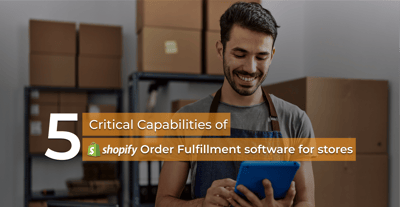Headquarters
175 S Main St Suite 1310,
Salt Lake City, UT 84111

Ship From Store is one of the most effective fulfillment strategies in an omnichannel retailer’s playbook.
It shortens delivery times, puts store inventory to better use, and adds flexibility to online fulfillment. But there’s a catch, if every SKU is treated the same, things can quickly go off track.
Fast-moving products are better fulfilled from warehouses, while slower sellers or mid-season styles nearing end-of-life are often ideal candidates for store fulfillment. Yet many retailers treat Ship From Store as an always-on setting, without considering what’s actually on the shelves.
In this blog, we’ll go beyond when to use Ship From Store, we’ll explore which products make the most sense, highlight common risks, and offer a smarter, margin-aware strategy to make it work at scale.
Imagine you’re running a standard order fulfillment model: all online orders are shipped from a central warehouse. A seasonal dress that sells steadily online eventually runs out of stock at the warehouse.
Meanwhile, small quantities of that same dress still sit across retail stores, just not enough in one location to make restocking worthwhile.
At this point, you face several options: wait for walk-in customers to purchase the remaining stock, possibly offer discounts to accelerate sell-through, return the unsold inventory to the warehouse, or surface that product inventory online and fulfill orders directly from stores.
This is the moment where strategic order fulfillment decisions make all the difference. Make the wrong move, and that store inventory becomes dead stock. Make the right one, and it helps you capture sales you were about to lose, without adding new inventory.
Many retailers hesitate to expose store inventory online, reserving it exclusively for walk-in traffic. But that hesitation can be expensive. Here’s what’s at stake:
If the products don't sell in-store, they become outdated. Once the season passes, they are marked down or written off entirely.
Transferring unsold stock back to a warehouse later adds operational cost.
When an item is out of stock in a warehouse, it appears unavailable online, even if it's available in stores. Store inventory isn’t sold online, customers assume it’s unavailable, and abandon the purchase.
In short, holding back store inventory while online demand remains unmet is a missed opportunity to maximize sell-through, avoid markdowns, and improve product margins.
The key isn’t to enable Ship From Store for all products, it’s to identify which products benefit most from it.
When warehouse stock is depleted, surface available store inventory online to avoid lost sales, especially during critical selling windows like mid- or end-of-season.
Don’t wait for markdowns. Proactively use Ship From Store to clear out slow-moving products and improve inventory turns.
This strategy doesn’t just reduce dead stock, it also avoids costly transfers and extends the lifecycle of your products.
While strategic use of store inventory can boost margins, it's not always the right choice. There are scenarios that call for more caution:
For top-selling items in high-footfall stores, consider reserving a portion of inventory to ensure availability for walk-in customers.
If store teams are stretched thin, consider setting daily order limits to avoid impacting the in-store experience and ensure timely fulfillment.

Proceed with caution when surfacing products online that have extremely low store inventory. Selling the last few units can lead to overselling if in-store purchases happen at the same time. An alternative approach is to perform quick cycle counts for such items, so store teams can confirm availability before fulfilling online orders. This helps retailers avoid both overselling and underselling, while still making the most of available inventory.

Knowing when not to use Ship From Store is just as important as knowing when to use it.
Ship From Store isn’t just about speed, it’s about maximizing the value of the inventory you already own. By using store stock strategically, retailers can keep products moving, reduce end-of-season markdowns, and give slower-moving items a second chance to sell.
But success requires more than enabling every store for every order. It means knowing which products to fulfill from stores, when to make them available online, and how to do it without overburdening staff or compromising the in-store experience.
With the right strategy, Ship From Store can improve sell-through, reduce dead stock, and protect margins without increasing your overall inventory.
* * *
At HotWax Commerce, we help retailers build product-aware order fulfillment strategies using real-time inventory visibility and intelligent routing rules designed to maximize profitability.
If you’re ready to turn every store into a smart order fulfillment hub, let’s talk.



.jpg?width=400&name=Shopify%20Store%20Fulfillment%20vs%20HotWax%20Store%20Fulfillment%20(3).jpg)


-2.webp?width=400&name=5%20Factors%20Retailers%20Should%20Consider%20Before%20Launching%20Ship%20From%20Store%20(2)-2.webp)